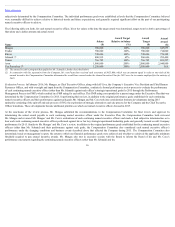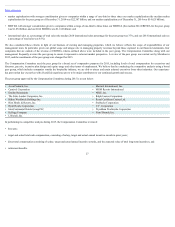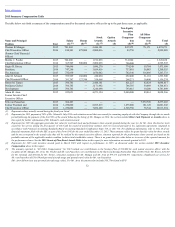Starwood 2015 Annual Report Download - page 26
Download and view the complete annual report
Please find page 26 of the 2015 Starwood annual report below. You can navigate through the pages in the report by either clicking on the pages listed below, or by using the keyword search tool below to find specific information within the annual report.
Table of Contents
executive officers are similar to one another and do not provide for a tax gross-up if the benefits payable thereunder are subject to the excise tax under
Section 280G of the Code. Instead, in such case, the benefits provided are reduced to the point that it would be more advantageous to the executive to pay the
excise tax rather than reduce benefits further. These change in control arrangements are described in more detail in the section entitled Potential Payments Upon
Termination or Change in Control below in this report. The change in control severance agreements are intended to promote stability and continuity of senior
management. We believe that the provision of severance pay to these named executive officers upon a change in control aligns their interests with those of
stockholders. By making severance pay available, we are able to mitigate executive concern over employment termination in the event of a change in control that
benefits stockholders. In addition, the acceleration of future grants of equity compensation vesting only in connection with certain changes in control (or certain
qualified terminations following certain changes in control) tracks market practices and provides these named executive officers with protection against equity
forfeiture due to all-encompassing Company changes or subsequent qualifying terminations and ample incentive to achieve Company goals, including facilitating a
sale of the Company at the highest possible price per share, which would benefit both stockholders and executives. In addition, we acknowledge that seeking a new
senior position is a long and time-consuming process. The aggregate effect of our change in control provisions is intended to focus executives on maximizing value
to stockholders. In addition, should a change in control occur, benefits will be paid only after a “double trigger” event as described in the section entitled Potential
Payments Upon Termination or Change in Control below in this report. We believe benefit levels have been set to be competitive with peer group practices.
Employment Arrangements with Named Executive Officers
Employment Agreement with Mr. van Paasschen. During 2015, we were a party to an employment agreement with Mr. van Paasschen that ran through
December 31, 2016, generally intended to renew on an annual basis unless otherwise terminated. In terms of material provisions, this agreement established certain
basic terms of Mr. van Paasschen’s compensation arrangement with us, including a minimum base salary of $1,250,000, participation in our annual incentive
program and long-term equity program at minimum participation levels (including annual target long-term equity award opportunities of $7,500,000), and
entitlement to the perquisites and personal benefits described above plus our customary retirement and health and welfare benefits. The severance and related
arrangements that were provided for under Mr. van Paasschen’s employment agreement were superseded by the terms of Mr. van Paasschen’s Separation
Agreement and General Release, as described in more detail below and in the section entitled Potential Payments Upon Termination or Change in Control in this
report.
Separation Agreement with Mr. van Paasschen. On February 17, 2015, we announced that Mr. van Paasschen had resigned as the President and Chief Executive
Officer and as a member of the Board effective February 13, 2015. On February 16, 2015, Mr. van Paasschen entered into a Separation Agreement and General
Release with us pursuant to which his employment continued until February 28, 2015 and he agreed to serve as a consultant to us from February 28, 2015 through
May 31, 2015, and under which he has been entitled to receive certain payments and benefits. Our separation and consulting arrangements with Mr. van Paasschen
are described in more detail above and in the section entitled Potential Payments Upon Termination or Change in Control below in this report.
Employment Agreement with Mr. Aron. Effective as of February 14, 2015, we were a party to an employment agreement with Mr. Aron that ran through
February 14, 2016, unless otherwise terminated pursuant to the agreement’s terms. In terms of material provisions, this agreement established certain basic terms of
Mr. Aron’s compensation arrangement with us as Interim Chief Executive Officer, including a minimum base salary of $1,000,000 per year, participation in our
annual incentive program for 2015 at a target opportunity of $2,000,000 and maximum opportunity of $3,000,000, the 2016 stock grant opportunity described
above, and entitlement to the perquisites and personal benefits described above plus our customary retirement and health and welfare benefits. The severance and
related arrangements that were provided for under Mr. Aron’s employment agreement were superseded by the terms of Mr. Aron’s Separation Agreement, as
described in more detail below and in the section entitled Potential Payments Upon Termination or Change in Control in this report.
24
























